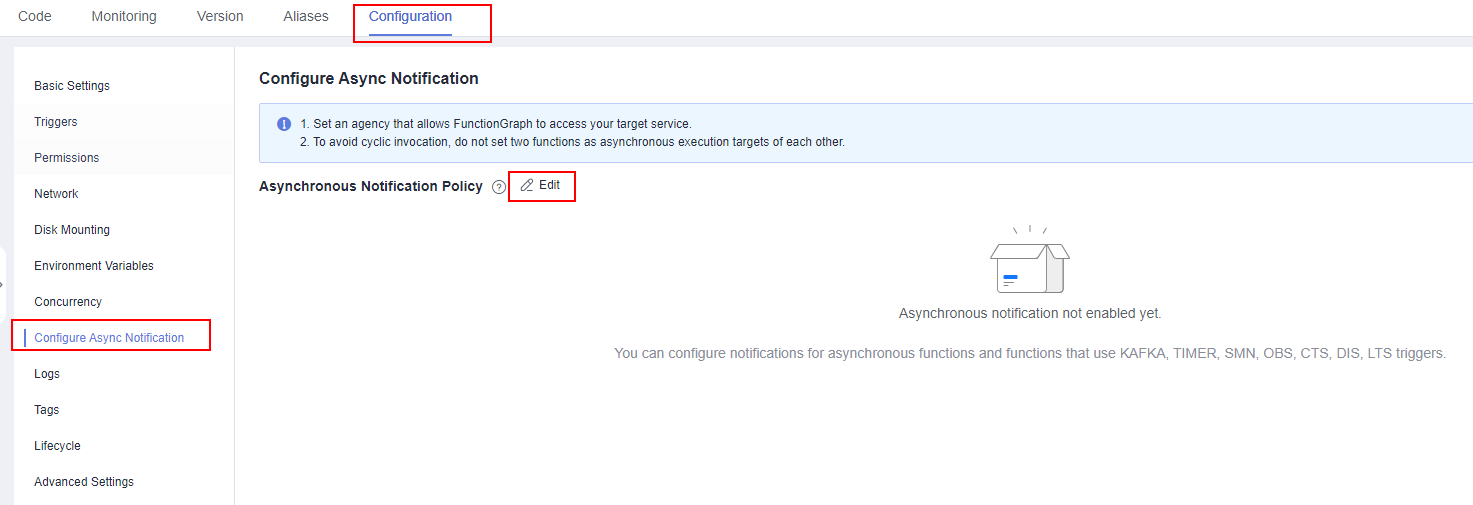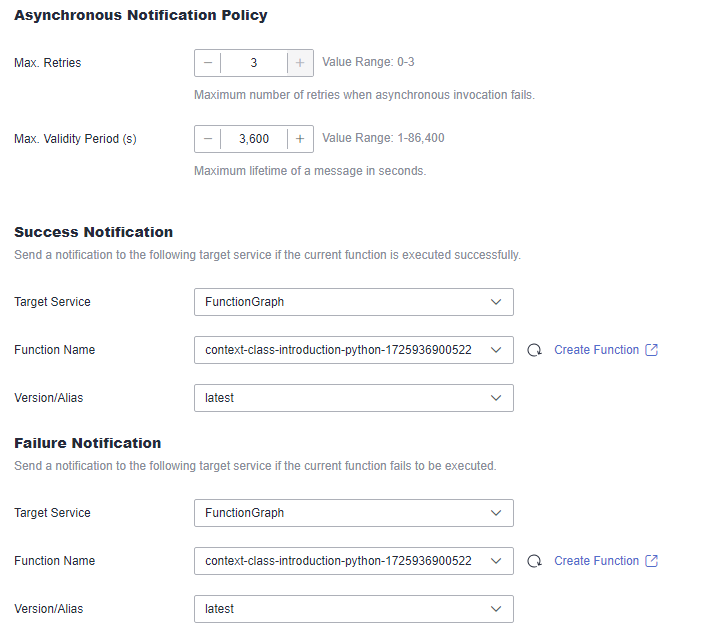Configuring Asynchronous Execution Notification
Overview
Functions can be invoked synchronously or asynchronously. In asynchronous mode, FunctionGraph sends a response immediately after persisting a request. The request result cannot be known in real time. To retry when an asynchronous request fails or obtain asynchronous processing results, configure asynchronous settings.
Applications Scenarios
- Retry: By default, FunctionGraph does not retry if a function fails due to a code error. If your function needs retry, for example, if third-party services often fail to be invoked, configure retry to improve the success rate.
- Result notifications: FunctionGraph automatically notifies downstream services of the asynchronous execution result of a function for further processing. For example, storing execution failure information in OBS for cause analysis, or pushing execution success information to DIS or triggering the function again.
- Set an agency that allows FunctionGraph to access the target service.
- To avoid cyclic invocation, do not set two functions as asynchronous execution targets of each other.
Procedure
- Log in to the FunctionGraph console, and choose Functions > Function List in the navigation pane.
- Click the name of the created function.
- Choose Configuration > Configure Async Notification. On the displayed page, click Edit next to Asynchronous Notification Policy.
Figure 1 Configuring an asynchronous notification policy

- Set parameters by referring to Table 1. For example, specify FunctionGraph for Target Service, as shown in the following figure.
Figure 2 Setting parameters

Table 1 Parameter description Parameter
Description
Asynchronous Notification Policy
- Max. Retries: maximum number of retries when asynchronous invocation fails. Value range: 0–3. Default value: 1.
- Max. Validity Period (s): maximum lifetime of a message in seconds. Value range: 1–86,400.
Success Notification
Target Service: to which a notification will be sent if a function is executed successfully.
- FunctionGraph
- OBS
Failure Notification
Target Service: to which a notification will be sent if a function fails to be executed.
- FunctionGraph
- OBS
- Click OK to complete the configuration.
Configuration Description
For details about how to set the target for asynchronous invocation, see Table 2. The following shows an example:
{"timestamp": "2020-08-20T12:00:00.000Z","request_context": {"request_id": "1167bf8c-87b0-43ab-8f5f-26b16c64f252","function_urn": "urn:fss:xx-xxxx-x:xxxxxxx:function:xxxx:xxxx:latest","condition": "","approximate_invoke_count": 0},"request_payload": "","response_context": {"status_code": 200,"function_error": ""},"response_payload": "hello world!"}
Parameter | Description |
|---|---|
timestamp | Time when the invocation starts. |
request_context | Request context. |
request_context.request_id | ID of an asynchronous invocation request. |
request_context. function_urn | URN of the function that is to be executed asynchronously. |
request_context.condition | Invocation error type. |
request_context. approximate_invoke_count | Number of asynchronous invocation times. If the value is greater than 1, function execution has been retried. |
request_payload | Original request payload. |
response_context | Response context. |
response_context.statusCode | Code returned after function invocation. If the code is not 200, a system error occurred. |
response_context.function_error | Invocation error information. |
response_payload | Payload returned after function execution. |
- Overview
- Applications Scenarios
- Procedure
- Configuration Description